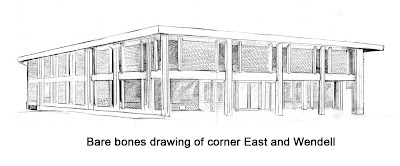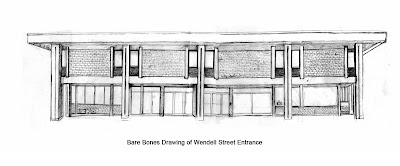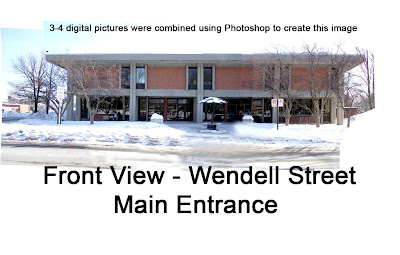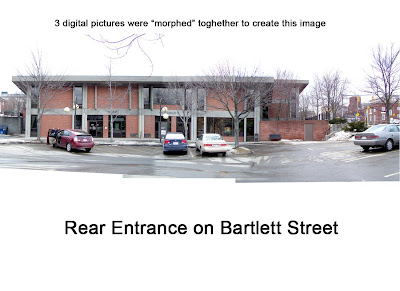I make full use of any high tech tool I can get my hands on if it will enable me to get to the painting part sooner. After drawing the bare bones sketches, I drew the other items separately...the benches, people, trees, cars, signage.....and then scanned everything. That way I could plug them into the drawing, moving things around and resizing until the overall scene met my approval. Photoshop is my best friend!
Another thing, this scene is going to be during spring, with the cherry blossoms in bloom. I searched the internet to find cherry trees.
If you come to the library during May and June, there will be a slide show explaining the entire process, displaying the reference photos and all of the steps taken from start to finish. Also my drawings and sketches and any other "work product" items will be on display. And 3 days a week during May I will be there painting and will be available to answer any questions about the process. I'll be located in the front part of the library, near the main entrance.
Monday, March 30, 2009
The Selected View
View from the Corner of East and Wendell Streets


The view that was selected by the "Friends of the Athenaneum" for the painting is the one that captures the front and side of the library. Notice I plugged some people into this sketch.
Next step is to finalize the scene with a more detailed drawing. It will become more "populated" with people, some of the positioning will change a bit, more of the pavement and landscaping will be drawn in, there will be shadows and shading, in essence, it will look more finished. However, I can still do some minor adjusting even during the painting stage, sometimes the obvious is not so obvious until that stage...but essentially, this is the view that the painting will be based upon.
Dressing Up the Sketches

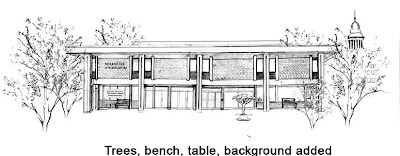
Using the two "bare bones" sketches, I added in trees, shrubbery, signage, benches, in order to see which view presented the most interesting and desireable one on which to base the painting. This is how I present my sketches to my house portrait clients as well. But let's face it, a sketch is not a painting and you need to trust the artist to turn that sketch into a beautiful painting. And you also need some imagination. There's a lot more that will go into the final detailed drawing, but right now we just want enough to select the best view for me to focus on.
Monday, March 23, 2009
Step 3 - Bare Bones Sketching
When I draw a building, I try to concentrate on the "bare bones" ... no trees, signage, benches, not even shadows or shading, nothing that will obstruct the skeleton of the structure in any way. Even if trees or signage will ultimately cover some sections of the building, it is important to understand what is behind them.
Also, before drawing the "big picture", I often practice drawing some of the areas that might be challenging.
In this case, all my photos were done during winter, with snow on the ground, and bare trees. In one respect it is great to do the photo shoot in winter, it makes it much easier to see all of the lines of the building. However this painting will be a springtime scene and that required some research into what those trees will look like in the spring with the cherry blossoms ready to pop. The internet can be a life saver sometimes.
Next up, some "bare bones" sketches........
Also, before drawing the "big picture", I often practice drawing some of the areas that might be challenging.
In this case, all my photos were done during winter, with snow on the ground, and bare trees. In one respect it is great to do the photo shoot in winter, it makes it much easier to see all of the lines of the building. However this painting will be a springtime scene and that required some research into what those trees will look like in the spring with the cherry blossoms ready to pop. The internet can be a life saver sometimes.
Next up, some "bare bones" sketches........
Step 2 - Study the Photos
This is where skill in Photoshop comes in handy. Let's face it, photos do not always give you the real picture....they sometimes lie. They can distort, and often do. I use a digital camera to take "section" shots, then I "morph" them together using photoshop, correcting the distortion.
Close ups of architectural details help when drawing and the distant shots (or memory) are just not doing it.
But remember, it's always good to do some sketching onsite as well.
Next - three views of the building that I thought should be considered for the final view.
Close ups of architectural details help when drawing and the distant shots (or memory) are just not doing it.
But remember, it's always good to do some sketching onsite as well.
Next - three views of the building that I thought should be considered for the final view.
Step 1 - Getting to Know You
Before touching pencil to paper, I feel it is critical to visit the property, get to know it....understand its place in the "neighborhood", the overall environment, the architectural details, the colors, the textures, the trees and shrubbery. A portrait of a building is not unlike a portrait of a person...it has history, character, charm, personality....and that is what you want to capture. Which is why I say visit the site many times before even taking pictures.
Next, take tons of pictures, different angles, perspectives, close-ups, distant shots, at different times of the day, and also the neighboring buildings.
Next, take tons of pictures, different angles, perspectives, close-ups, distant shots, at different times of the day, and also the neighboring buildings.
Getting Started!
Welcome to the very first entry for the Berkshire Athenaeum Portrait blog.
First a little history .... what is this project all about anyway?
Many months ago I was invited by the Friends of the Berkshire Athenaeum (Pittsfield's public library) to paint a new portrait of their beautiful facility to commemorate the building's 35th anniversary. When the painting is completed sometime this June, it will hang in the front entrance of the library.
The actual painting of the portrait will take place during business hours in the library, and anyone who is interested is invited to watch it unfold. A schedule will be posted, and I will be there at different days and hours in order for those with varied schedules to come and witness art in the making.
But the project involves so much more.
This blog is just one part of a multi-faceted approach to provide the public with information about what it takes to paint a building portrait in watercolor. Read the recent press release issued on March 18, 2009 for more information, and stay tuned right here as I frequently add more information.
Just so you know, I have never done anything like this before (painting in public) so I am both a bit nervous and very excited. I expect to be painting in the library the latter part of April, all of May and maybe the early part of June. Besides actually painting and answering any questions, I will display my preliminary sketches and drawings and also run a slide show continuously on a digital frame so you can see what has already taken place.
Next entry will explain the "behind the scene" steps that must be taken before even thinking about painting.
First a little history .... what is this project all about anyway?
Many months ago I was invited by the Friends of the Berkshire Athenaeum (Pittsfield's public library) to paint a new portrait of their beautiful facility to commemorate the building's 35th anniversary. When the painting is completed sometime this June, it will hang in the front entrance of the library.
The actual painting of the portrait will take place during business hours in the library, and anyone who is interested is invited to watch it unfold. A schedule will be posted, and I will be there at different days and hours in order for those with varied schedules to come and witness art in the making.
But the project involves so much more.
This blog is just one part of a multi-faceted approach to provide the public with information about what it takes to paint a building portrait in watercolor. Read the recent press release issued on March 18, 2009 for more information, and stay tuned right here as I frequently add more information.
Just so you know, I have never done anything like this before (painting in public) so I am both a bit nervous and very excited. I expect to be painting in the library the latter part of April, all of May and maybe the early part of June. Besides actually painting and answering any questions, I will display my preliminary sketches and drawings and also run a slide show continuously on a digital frame so you can see what has already taken place.
Next entry will explain the "behind the scene" steps that must be taken before even thinking about painting.
Subscribe to:
Posts (Atom)
